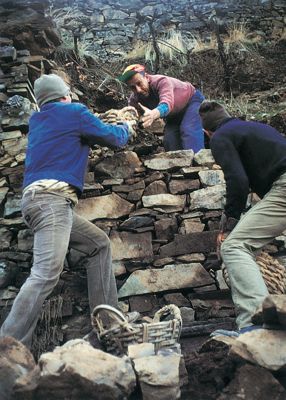 In a territory in which the small plots of cultivable land, the ciàn as they are called in the local dialect, have been created by man and woman who have taken with their arms the necessary terrain, the schedule of activities is set by the climatic rhythms of nature. The cycle of production is thus variable . The know-how for the production of Sciacchetrà (shok-eh’-trà) has developed throughout time and has been transmitted from generation to generation producing a culture and a tradition ( a heritage) still alive today.
In a territory in which the small plots of cultivable land, the ciàn as they are called in the local dialect, have been created by man and woman who have taken with their arms the necessary terrain, the schedule of activities is set by the climatic rhythms of nature. The cycle of production is thus variable . The know-how for the production of Sciacchetrà (shok-eh’-trà) has developed throughout time and has been transmitted from generation to generation producing a culture and a tradition ( a heritage) still alive today.
The only feasible structural intervention to modernize vine growing has been the setting by of the monorail in 1980 by Cooperativa Agricola, 16 km located in the steepest slopes often in beautiful and distant places. In these places grapes are no longer carried by arms from the vines to the winery.
The rhythm of activities is determined by seasons: the grapes harvest can start, in autumn, only when the grapes are perfectly ripe, in a delicate relation to sun and rain. Immedaitely layed to dry on the trellises grapes will be gathered at the precise moment when they are properly dried, depending on a mix of wind ( humid or dry) rain and sun. Finally, in the winery, the various phases of vinification, as no yeasts are added, are determined by the spontaneous times of fermentation and transformation of sugars in achoholic percentage. In winter, the activities of pruning are set by the autumn climate, by which the vines will loose their leaves. Added to the fatigue to cultivate theese small plots rescued from the steep slopes of a very “scheletrica” soil, there is the need to maintain the stone walls. The rhythm of activities in spring and in summer: inspection and protection, is usually less intense, in relation to climatic variance.
